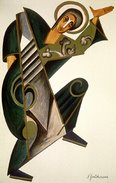farcire, "farsch"
Farcire in Classical Latin meant 'to stuff, cram, fill full.'
For example, Pliny, writer of Rome's first encyclopedia, wrote of a mason who set out
medios parietes farcire fractis caementis
'to fill the interior of the walls with crushed stone.'
You can see the ancestor of our English word cement in the Latin caementis.
The passive form of the verb farcire was used to describe gagging as part of torture:
in os farciri pannos imperavit
'he ordered rags to be stuffed in the person's mouth.'
A farse was a word or phrase inserted or stuffed into the ordained words of prayers and of the Roman Catholic Mass. From the 9th to the 12th centuries, tropes (extra phrases) began to be added to the music and the texts of the Latin liturgy
"there is a short prayer called the kyrie eleison, which is Greek for 'Lord, have mercy.'"
kyrie genitor ingenite, vera essentia, eleison
'O Lord, unbegotten begetter, true being in all things, have mercy.'
The 'unbegotten begetter' referred to Christ's birth of the Virgin Mary.
Farses spoken or sung in vernaculars like Early French also served as a gloss on the Latin of the Mass, of prayers, and of epistles and readings, to make the congregation, who knew little or no Latin, aware of the meaning of the texts. Lessons and Epistles so altered were called in early French épitres farcies, used especially at important times in the church calendar, such as Christmas Day, to ensure the laity understood the story of the birth of Christ.
In 16th century Italy, these farse formed the basis for commedia dell'arte with stock characters like Arlecchino, Punchinello, Colombina, and Pantalone who influenced comedies by Ben Jonson and Molière, and gave rise to characters like Harlequin and Mr. Punch of Punch and Judy shows.

No comments:
Post a Comment